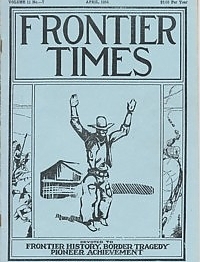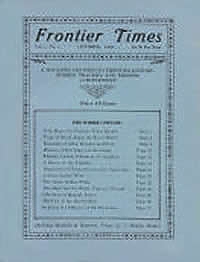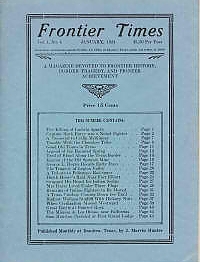By using our website, you agree to the use of cookies as described in our Cookie Policy
Magazines & Instant Downloads
Vol 11 No. 07 - April 1934
Zachary Taylor's Encampment at Corpus Christi
By Coleman McCampbell. CORPUS CHRISTI first came into national prominence with the encampment of Taylor's Army of Occupation on its beach. Prior to that time it was known as Colonel Kinney's Ranch and Trading Post. This is an interesting account of the earliest days and history of the area. When, in August, 1845, General Taylor's troops entered Corpus Christi Bay they found the town to be a very small village at the head of the bay: a town comprised of a few houses on the west bank of the Nueces. The inhabitants were said to be smugglers and lawless persons " to whom war was prosperity and satisfaction."
Mentions further: Fernandez, governor of Tamaulipas, etc,
Early Postal Service in Texas
By John S. Oglesby. Fascinating and detailed account of TX postal system in earliest times. Mentions: Colonel Hitchcock's diary, President Burnett and his staff at Harrisburg, "A General Postoffice was established in the Republic of Texas, on December 20th, 1836. Postage rates were: "For every letter composing a single sheet of paper, and conveyed any distance not exceeding fifty miles, 6 1-4c; over fifty and not exceeding one hundred miles, 12 1-2c; upon all ship letters, 6 1-4c shall be charged, in addition to the above rates" Many details regarding locations/distances of early routes. Felipe and Nathaniel Robbins at Randolph. Piney, Cedar Springs, Washington and Fanthorp's Postoffice, Gustavus E. Edwards; James Whiteside; Stephen R. Roberts; Issac Batterson, San Felipe, Henry Raguet was postmaster at Nacogdoches, Collin Allridge, Washington Lewis, William Whitelet at the Neches River, John Rice Jones, Samuel Steddam, James Gaines at the Sabine River, A route form San Felipe. to Velasco, ninety-eight miles, with Gail Borden, Sr., as postmaster at Louisville, J. A. E. Phelps at Orozimbo, Willis A. Faris at Collumbia, John Shapp at Brazoria and J. C. Hoskins at Velasco was given to Madison Stephens a carrier at one 1thousand dollars a year. San Felipe to Liberty, a route covering one hundred and seven miles, was held by Johnson Hunter at Rocky Well, D. W. C. Harris at Harrisburo, William Hardin at Liberty, Clairborne West, S. H. Everett at Chambersburg, S. H. Everett, Albert G. Kellog at San Augustine, PLUS MANY, MANY MORE NAMES, LOCATIONS & ROUTES DESCRIBED IN THIS EXCELLENT ARTICLE.
Tom Caraway-Pioneer
By Mary E. Kelley, ADVENTURE LIKE a theme song, runs through the story of "Uncle Tom, "Tom Caraway's life…born at Burr's Bluff, in Newton county…a resident for the greater part of his life of Hardin county" near Silsbee. Few men living in East Texas today can lay claim to a life filled with as much color and action as Uncle Tom's. Uncle Tom tells how, at the age Of 11, he killed a panther; how he hunted bear; how he invested his first earnings; how he learned to set up a sawmill; how he learned to read and to write-these and a score of other interesting tales from an old man, rough-hewn but dependable, cause his listeners to draw nearer and to lose all account of the passing of time. Great article of old frontier events from eye-witness further mentions: Randel West, Bear Man's Bluff., Yellow Bluff, later known as Cairo-a town which is no more. Van Meter's tram, the old East Texas Railroad at Sabine, Concord, Uncle Tom's postoffice., L. D. Scarborough, later county surveyor of Jasper county, a keel-boat Captain Wilson, The Caraways, Grandma Calder of Beaumont, Mary Perryman of Town Bluff, etc
William W. Hunter a Coleman County Pioneer
By Beatrice Grady Gay (Continued from last Month) Account related by Mr. Williallim W. Hunter (the Patriarch of Coleman county) of Santa Anna, Texas. First-hand account of experiences and particulars of the settlement of central Texas. An Excerpt: "We trailed the Indians straight across the plains to the Clear Fork of the Brazos, passing by Santa Anna mountain, which was their usual trail. We rode hard for two days and one night without stopping for food or water. The second afternoon we came upon the body of the little girl who bad been killed and her body hung up by a buffalo thong in the crotch of a wild China tree out on the plains. We cut the little body down and turned our faces toward home. That night we rode until we found water at where we made camp and lay down to sleep, still without food. We had no time on a scout like that to equip ourselves with provisions or other necessities." And another:, "Rev. Childress had another son, Mark, who became one of Coleman county's early ranchers. He established a ranch at Post Oak Springs, at the head of Home Creek, in the western part of the county. He used to market his cattle at Abilene, Kansas, which was one of the first important out-of-state cattle markets for Texas cattle. I remember one drive in particular. Mr. Childress took fifteen hundred head of steers, and started them five hundred in a bunch for three days, thus making them easier to handle. The first herd made the trail, and set the pace for the others to follow; each night the second and third herds would be bedded down where the first and second herds had been bedded the night before. In the later days before the coming of the railroad to our county, many a herd of cattle from Coleman county went over that same trail."
Mentions: Dave Upton, Trickham on Camp Branch, the Rendleman farm Mr. Meng Charlie, Etherwood. McCaim, Grandpa Cason Pecan Spring, in the north western edge of Coleman county, Burl Brown, an old man named McReynolds, Deep Creek, where it flows into the Colorado River, Fort Concho, Mud Creek, an old Methodist circuit rider, by the name of Childress., There was also an early day school taught at Trickham by Dave McCallister.
The Alcalde of Fort McKavett
By Eugene Cunningham, El Paso, Texas. BACK IN 1852 THE Comanches, the Kiowas and the Apaches, came almost openly, almost contemptuously, to pillage and murder the tiny settlements and isolated farms and ranches of Texas. Among other frontier military posts, the Government established Fort McKavett on the headwaters of the lovely San Saba, among the wooded, pleasantly rolling ridges of what is now the western line of Menard County. This post was built on land belonging to one Robinson, of New England. Garrisoned by regulars until the outbreak of the Civil War, the post was then abandoned for four years by the soldiers. Only a handful of sturdy pioneers used it during the war. It served them as a protected place for their families against the steady maraudings of the Indians and as a point of departure for their counter-blows at the savages. Then the Army came back, The post was enlarged. Stone barracks, officers' quarters, hospitals; storehouses-over a million dollars was spent on fine stone buildings. McKavett became a ten-company post….
Mentions further: John Fleutsch, the Swiss-born, German-speaking justice of the peacew, a real character in every sense, who wielded law with frontier flair: "The crowd yelled for a speech from the new alcalde. So John Fleutsch smiled generally and, for all his broken English, made a good speech: "Fellow citizens," he said slowly, "I thank you for the confidence with me by this occasion. I never ask f or this office. But for your Joostice of the Peace you have elect me and now I tells you that, with your help, 1 will make the bad mans hard to catch! "'About the law by the book I don't know nothings. But I know what is right. And I know what is wrong. And right now, I tells you cowboys: When you comes to the town and you shoots it up with your pistols up, I sends you to shail, by Criminy! "And my fellow citizens, I tells you right noR, all right, that the bad mans that stay in McKavett and tries his devilment up to keep-he was much better be in hell with his back broke, already! You stays with me and I stays with you and we makes good times by McKavett." Now, this was the sort of talk the McKavett folk understood. The sort that suited them down to the ground ' No monkey-business about legal technicalities; just plain courage and horsesense, of the variety they knew this ex. soldier owned. They cheered him until the roof rang, then elected George Niel to serve as the constable.."
Mentions: Roy Bean George Niel, John Warren Hunter was McKavett's pioneer schoolmaster., etc.
Fredericksburg Rebuilds Church, Erected in 1847
By Esther Mueller. GERMAN COLONISTS who in 1846 settled Fredericksburg under the auspices of a society of German noblemen brought with them from their various provinces one thing common to all, deep religious loyalty. A year after their arrival in the wilderness of Texas the colonists, though harassed by the trials of colonization, erected a community church house that served the town for fifty years, the historical Vereins Kirche. This is the story. Includes old B&W image of the church.
Mentions further: The octagonal building, whose unique structure was unlike that of any other in the country, was planned by Dr. Schubert, Adelsverein director. Fredericksburg, Coffee Mill, Lee Kiehne of Fredericksburg was architect, Gillespie Co, Jenniger's Fest Ausgabe, Frederich Armand Strubberg, the first director of the colony of Fredericksburg., Meusebach, general commissioner of tile colony, The celebration of the first laying of the corner stone was held in the spring of 1847, when the town was scarcely a year old. On the day when the corner stone of the Vereins Kirche was to be laid the Comanches appeared in Fredericksburg, led by their chiefs, Ketemoczy and Santana, both gorgeously arrayed in beaded buckskin and feathered headdress. The Indians brought with them tanned hides and deerskins filled with wild honey and bear fat, to trade to the settlers. John 0. Meusebach, Pastor Dangers, Julius Rusebe,
Advertised For Teaching Job 60 Miles From Preacher
This novel advertisement appeared in the papers of the state about 25 years ago. It got results for T. J. Womack, who recently visited his daughter and son-in-law Mrs. M. A. Avinger, 716 Avenue J. The job he secured was in that mountain village of Shafter, near Marfa, where the state's greatest silver mine is to be found today. If Mr. Womack, a teacher in rural schools for more than 40 years, had measured the distance to Marfa, lie perhaps would have found that there was a Baptist minister just about that distance away. He liked it at Shafter, the frontier has always appealed to him since as a boy lie attended a Sunday school near Llailo while the skirmishes leading to the Packsaddle mountain Indian fight were underway. His tales of early days a school teacher are filled with gun plays debating societies, threats to whip the teacher.
Mentions further: Willow City near Fredericksburg, Captain Green Harrison, Rheingold community, Emil and Otto Gold, Alex Roberts, brother of Captain Dan Roberts of the Rangers, Jim Renick, Lakeview, Briscoe County; one year at Danevang, in Wharton County, Dripping Springs, Ida Roberts, Jake Roberts, Mr. Moore, Round Bottom,
The Tragedies of the Gila
By Charles A. Gianini, Poland, N. Y.
Into these forest rimmed canyons came men who had left other parts for the mutual benefit of all, and it was in this wild country that I heard the gruesome story of the tragedies and I repeat it as told, except that I have disguised the names. The men who settled in these hills and valleys were safe from pursuit for it was a very difficult country to travel in, and with, its many canyons both large and narrow, and in them numerous eaves in the cliffs a more perfect hide-out could not I be found.
Mentions further: West Fork, I will call these men Jones on the Middle Fork and Brown on the West Fork.,
Founding of San Saba County
By Alma Ward Hamrick
THE EIGHTIETH anniversary of the founding of San Saba county is being commemorated by San Sabans during 1934 in a series of programs, articles written on early days of San Saba county, possibly, the presentation of a pageant, and many reunions including the eleventh annual San Saba County Old Settlers' reunion here in August.
Mentions Further: David Itatsler, Cherokee Creek, Burnet county, Matslers, Tom Matsler, Count Meusebach of Germany, Gustave Schliecher, San Saba River valley, Colony of Forty, David Matsler, Schliecher, Boyett, Abner Gregg , Melding Dawson, W. H. Smelser, Judge Joab Harrell, S. A. Houston, cousin of the illustrious Sam Houston, who came from Tennessee, Rev. Arnett, H. W. Marley and others., Simpson Creek community, Joe and Jim Barnett, T. P. Hamrick, Sam Linn, D. A. Harris, W. W. and Jim Crawford, J. M. Harkey, Harkeyville, Jackson Brown, and J. McDaniel, Richland Springs section James Wood and four sons, with a friend, A. Woods, Dr. Sloan and two sons, Dr. Allen, Jerry Pleming, M. H. Wads. worth, Henry W. Ellis, A. J. Rose who ran the Rose Mill there for many years, the Lathams, Hendersons, Thaxtons and others, Babyhead Indian fight, Hanna,Hext,R.W. and G. J. Gray, Kuykeiidall, Barbers and Montgomery., Dr. J. C. Rogan, Dr. J. C. Hudson, J. S. Wil.liams, G, B. Cooke, Freestones, W. T. Murray and T. W. Ward who were the founders of the Ward-Murray Bank, now City National Bank, Seventy-sixth Annual Methodist Camp, Mrs. Elizabeth Houston Kell, and George Matsler, Presbyterian, U. S. A.; J. D. Estep, Church of Christ ~ Mrs. May Ward Homan, Catholic, and Mrs. John Brown Carroll,
Thomas Clayborn Osborne
By T. U. Taylor THE VENERABLE Thomas Clayborn Osborne has lived in Texas 83 years. He was born on Willbarger creek, lived in the old Hog Eye neighborhood, two miles southeast of Elgin, and now resides in Bastrop. He is still hale and hearty and has made several trips up the old cattle trails to Kansas and Nebraska. He came to Texasin 1885 from Tennessee.
Mentions further: Colorado River near Pack Saddle Mountain, Brazos, Nolan River , Cleburne, Belton, Caddo Peak, Johnson county, Ft. Worth and old Birdville, Red River, Red River Station, Cook county, Ellsworth, Kansas, Ogallala, Sam Bass, Ellison, DeWees., Round Rock,
When Men Become Beasts
THERE ARE TIMES when the frenzied mob knows no law when men's reason seems to be thrown to the winds, and vengeance swift and terrible is meted out to a beast in human form, as was the case in the burning of the Texas negro near Paris, Texas, in 1893. This horrible gruesome affair is vividly remembered by many people yet living in, We State, for it was given wide publicity in the newspapers at the time. The little three-year-old daughter of Sheriff Vance was carried away from home, and two days later was found murdered, hidden away, after having been brutally mistreated. The negro Henry Smith, who afterwards confessed to the crime, had assisted in the search for the missing child. As soon as suspicion pointed to him as being the murderer he was arrested and made a full confession. A mob soon gathered and the negro was taken, out and burned at the stake. The scene and manner of his death was described in an article which appeared in the San Antonio Express at the time, and is as follows: Mentions further: Henry Vance,
Mob Action in '60s Took 40 Lives
J. W. (Jack) Hughes, in Breckenridge Sun,
"I have watched and wondered for seventy years why during all that time I have never seen it mentioned in any publication south of the Mason and Dixon Line and only distorted accounts in Northern papers. I can only give a brief outline for if I should go into details I would have to write a book."
Mentions further: Cook and Grayson counties, Democrats and Abolitionists or Black Republicans, Confederacy Northern Democrats in Texas, Yankee general Blount, Red River, Newt Chance, Gainesville, Colonel James Young, Whitesboro, Texas,, Doc Edmondson, Elm Fork of the Trinity, Locke's Limb, Elm Harper's Ferry
Ranchman Who Dreamed of Making County Seat
By Gus Barr, in, San Marcos Daily News
IN THE EARLY DAYS of county organization in Texas, when the Southwest was a rich and unexploited section - when the ox cart and mule team caravans trudged frontier paths and the county doctor made his rush calls in a horse-drawn buggy, nature guided the course of locality settlement.
And so it was with historic Hays county.
Mentions further: Travis county, Colonel John C. Hays, Austin to San Antonio, Buda, Kyle, and San Marcos, Hays City, Williams ranch, London St., Ireland St., Scotland St., Japan St., and Holland St, Z. Williamson
$4.95
‹ Back








